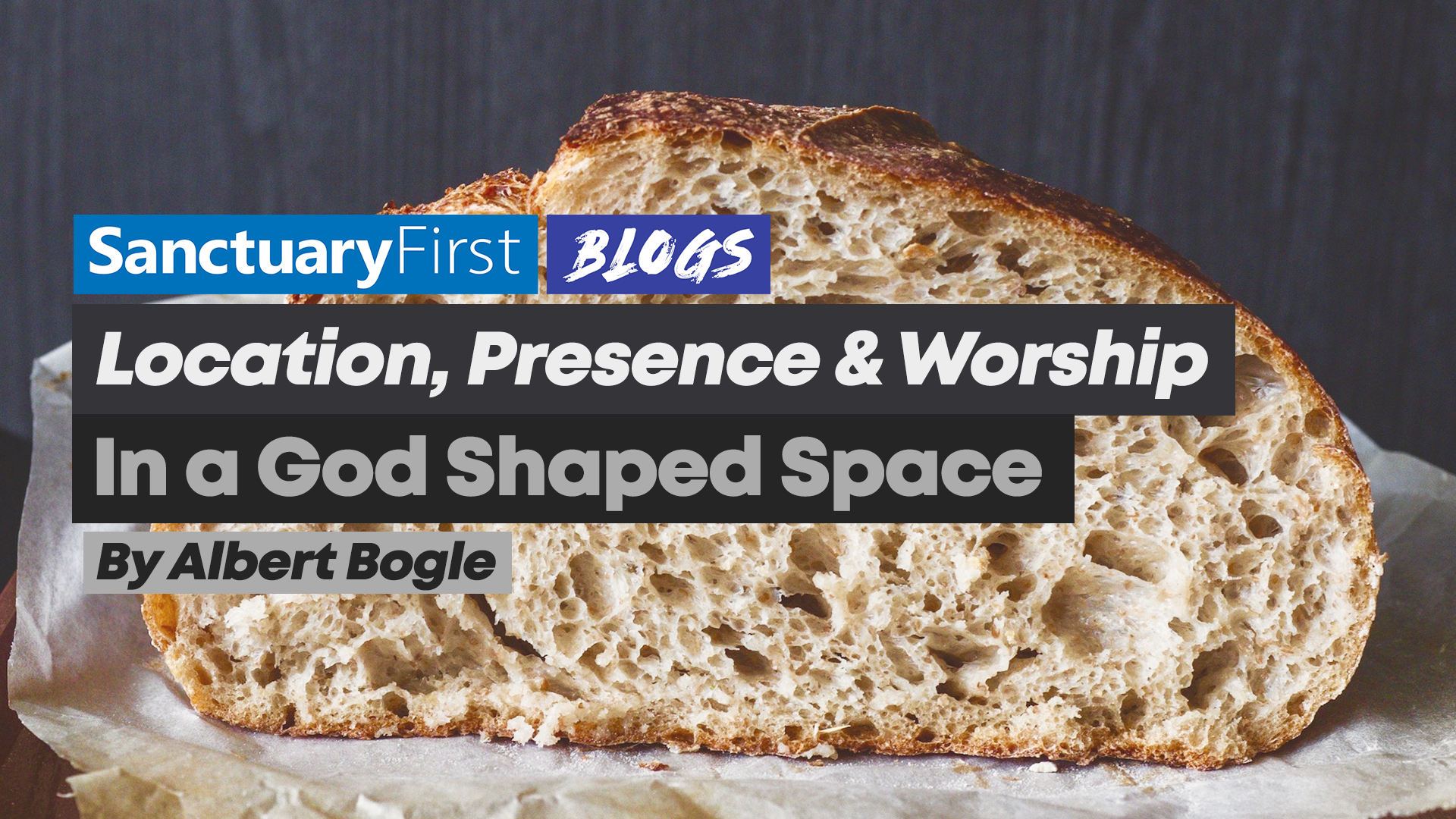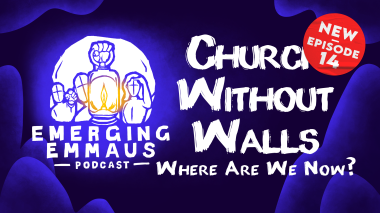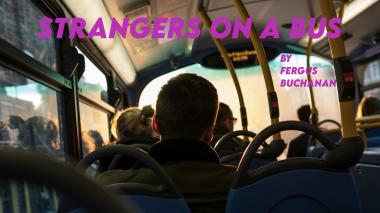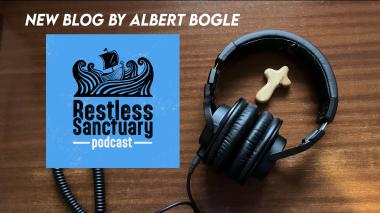Location, presence and worship in a God shaped space

 Here Albert Bogle touches on the insight new technology can bring to our understanding of the sacraments with reference to the Lord’s Supper. Asking questions about presence and real presence, and the value placed on local buildings in defining church rather than relationships centred around presence.
Here Albert Bogle touches on the insight new technology can bring to our understanding of the sacraments with reference to the Lord’s Supper. Asking questions about presence and real presence, and the value placed on local buildings in defining church rather than relationships centred around presence.
A Unique Expression
It is because we believe in the importance of integrating online and offline church that Sanctuary First can be a unique catalyst, helping to create an expression of a universal worshipping community. One that creates and encourages networks of believers both on and offline.
Exploring how to administer the sacraments within an online fellowship continues to exercise our thinking. Some wonder if church law gives permission for online celebration of sacraments within the Church of Scotland? The relevant act is Act V 2000, the Consolidating Act anent the Sacraments (as amended by Act IX 2003). The Act sets out stating “The Sacrament of the Lord’s Supper shall normally be celebrated in Church at stated times determined by the Kirk Session.” However it continues to say “The Sacrament of the Lord’s Supper may be administered privately in Church or elsewhere at the discretion of the minister.” The latter is normally understood by ministers to allow ‘Home Communions”. While the act does not explicitly permit online celebrations of Holy Communion, it certainly does not forbid it.
Online communion can be both narrowcast to a few people interactively, or broadcast to a wider group of people with less interaction. It is the limitation of the medium that continually frustrates us from completely embracing that which is signified. Bread and wine, can signify a material physical presence, yet the internet signifies theologically the otherness of the presence of God beyond our physical space. The metaphorical application of the internet and the physical presence of bread and wine brought together, manifest a new dimension of sacred space, especially when seeking to understand the omnipresent nature of God. It is a rich seam to mine.
The discovery of technology integrating with theology to enhance our spiritual understanding of presence needs to be celebrated, rather than dismissed. It is an exciting prospect to continue to reflect upon the ways which God reveals more of his being to humanity in Christ. Surely the reason why we still live and move and have our being in him, is that he has more to reveal to us about who we are in him.
Dealing with the practicalities of baptism remains challenging but not insurmountable. A networked community can arrange baptisms to take place and be recorded within the network of congregations. If bread and wine can be set aside for a holy use at a distance by the power of the Holy Spirit at work in our prayers surely water can also be set aside for baptism.
 However creating opportunities for worshippers to participate in Holy Communion online has become an important part of Sanctuary First worship and a blessing to those who take part. We are challenging the assumption that a worshipping community can only be geographically based. Sanctuary First by its existence brings into question the belief that only congregations living and working in secure geographical boundaries, and serving those who live within these boundaries, can be recognised as valid worshipping missional communities. We need to rethink our ecclesiology (the study of the form and role of the Church).
However creating opportunities for worshippers to participate in Holy Communion online has become an important part of Sanctuary First worship and a blessing to those who take part. We are challenging the assumption that a worshipping community can only be geographically based. Sanctuary First by its existence brings into question the belief that only congregations living and working in secure geographical boundaries, and serving those who live within these boundaries, can be recognised as valid worshipping missional communities. We need to rethink our ecclesiology (the study of the form and role of the Church).
In seeking to understand what a relevant ecclesiology might be for an online worshipping community we have re-engaged with the Church Fathers. Thinkers like Ignatius, Irenaeus and Athanasius have all got something to teach us about the universality of the church. For them knowledge of God was discovered through the experience of the ecclesial community. This development of thought came about because they understood God as an ecclesial being. For them God could only be known through personal relationships and personal love. This is summed up neatly by John Zizioulas in his book Being As Communion here he simply says “Being means life, and life means love” (page 16). If you unpack this at the heart of this ecclesiology is the person.
In addition to all this, their understanding of church as an ecclesial entity, could not be simply established by geographical or local expression. The true encounter came about through the manifestation of Christ in the act of Communion which was and is an eschatological event.
It is something that happens outside of time and space yet is manifest and communicated and transmitted in bread and wine through and in time and space. And while to talk of the real presence of the risen Christ being with us by faith, we should remember the Communion event is in reality itself only a foretaste of the ultimate reality of the consummation of all things. This is an important to understand because it points to a new understanding of what we mean by “longing”.
It also challenges the idea that a believer participating in the act of Communion by faith can be alone. It is this longing for what has still to be that makes us aware of the complete ecclesial community, past present and still to be. This is what it means in communion to speak of the real presence encountered in time. Calvin in his Institutes talks about ‘spiritual eating’. For him it is the Holy Spirit who lifts the believer up into the presence of the risen Christ seated by the Father. Christ is not in the bread, the bread simply signifies that relationship which is complete but not yet completely consummated. It is the foretaste of the marriage supper of the lamb.
In seeking to ensure the vitality and importance of the local geographical expression of Church, as opposed to the over centralising of church administration and strategy, there is a great danger in offering a vision of the church which is one dimensional. By this I mean, one building, one parish, one minister, one flock all within one geographical area. Even our latest thinking, in the Church of Scotland about hubs is centred around the positioning of buildings to each other as opposed to the relational dimension with people to each other. The Church is called to engage with following Jesus. It is a movement not a static localised monument.
Focusing too much on the local risks suggesting that the local church can exist independently on its own. I want to suggest that perhaps the internet opens up the possibility of a worshipping community which understands the meaning of living in a world interdependently. Opening up further the theological concept of what it means to be. ‘the one and the many in Christ’, or perhaps the many of the many in Christ.
In our desire at Sanctuary First to be an ecclesial community we have been exploring over the past few years the validity of sharing Communion through the internet. The result has been truly humbling as individuals and families feel connected within the communion of the saints through bread broken across the internet. All this gives a new meaning to what Jesus meant when he invited his disciples to cast their net on the other side. He would truly make them fishers of men. We are called to reach out to the many, if I can mix metaphor, “who are not in this fold.”
 In an act of Communion there is a mystery. The bread and the wine transmit the ecclesia or the body of Christ to the many. At this point, is there any reason why the internet cannot also become the transmitter of the Communion and fellowship being encountered in a specific geographical space? It is also engaging with that which is not local but transcendent and ubiquitous. Surely, we can include the internet when we talk of the power and presence of the Holy Spirit at work through and in all things? Even the ether of the internet.
In an act of Communion there is a mystery. The bread and the wine transmit the ecclesia or the body of Christ to the many. At this point, is there any reason why the internet cannot also become the transmitter of the Communion and fellowship being encountered in a specific geographical space? It is also engaging with that which is not local but transcendent and ubiquitous. Surely, we can include the internet when we talk of the power and presence of the Holy Spirit at work through and in all things? Even the ether of the internet.
If this is the case then the internet is a gift of God to the world through which he is enabling us to understand more fully what it could mean to live in communion with each other more fully moment by moment, regardless of our location.
The internet doesn’t respect geographical areas as such, just as God’s Spirit cannot be restrained or contained in an area. This of course brings to the fore some of the issues earlier, that surround what the church calls the provision of the “ordinances of religion”. While the Church of Scotland understands the phrase to “bring the ordinances of religion to the people in every parish of Scotland through a territorial ministry” to mean a commitment to maintain worshipping, witnessing and serving Christian congregations throughout Scotland; the key part of the phrase to my mind, is bringing the ordinances of religion to the people - and not being wedded to a methodology, i.e. ’through a territorial ministry’. This is about a method of delivery that suited a static, slow moving society. Society is different now— faster and more fluid and people are defined less by geography and perhaps more by digital technology.
Technology has shortened distances, and is changing behaviours. Therefore the church must be open to embracing new ways of bringing the ordinances of religion to the people. The answer may well be through connectivity not geography or buildings. If someone is worshipping and being nurtured daily by Sanctuary First, or an online congregation, surely this is fulfilling the role of a worshipping community?
The question must then be asked, what should the rules be surrounding for example the manner in which the Eucharist or Lord’s Supper is administered. It is questions like these that draw us into seeking to evaluate the authenticity of what we mean by ‘presence’ when we are engaging with digital technology. It is this type of inquiry that begins to create the space for Digital Theology to begin to flourish and contribute to our understanding of what we mean by living and communicating in a Digital world. Dr Pete Phillips of the Centre for Digital theology at Durham University writes:
Digital Theology is about bringing digital culture and theology together at high speed with colleagues from different disciplines, (theologians, scientists, artists, coders, computer scientists, sociologists, entrepreneurs, digital humanists, and designers), to see what happens; like a theological large hadron collider! Digital theology is about interrogating classical religious doctrines and determining how they apply within, or, are changed by contemporary digital culture, perhaps a form of contextual theology or perhaps constructive theology of some kind, since theology always has to speak in the language of its contemporary culture.
Perhaps Epstein’s reflections on how a new ‘humanology” is emerging, out of the technological age is a good reason for theology to begin to contribute to the larger debate, already in full swing, by anthropologists and sociologists.
I find it interesting that in a web article Hans Vestberg, the CEO of Verizon Communications makes the observation “For technology to deliver on its promise of human betterment, it needs a cultural and moral compass. If technology needs such a compass so does the church. Too many of our congregations are tied to their buildings. Their identity is not relational to each other but their identity is moderated through the church building.”
When our collective identity is based on an ecclesiology that is relational beyond time and space we begin to understand Communion in a different light. Buildings and their location, and locational proximity may begin to be less important to a generation of believers that understand location and presence can have another dimension.
Very Rev Albert Bogle, Minister of Sanctuary First




 Add to Favourites
Add to Favourites







Login to comment.